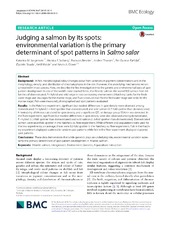| dc.contributor.author | Jørgensen, Katarina Mariann | |
| dc.contributor.author | Solberg, Monica Favnebøe | |
| dc.contributor.author | Besnier, Francois | |
| dc.contributor.author | Thorsen, Anders | |
| dc.contributor.author | Fjelldal, Per Gunnar | |
| dc.contributor.author | Skaala, Øystein | |
| dc.contributor.author | Malde, Ketil | |
| dc.contributor.author | Glover, Kevin | |
| dc.date.accessioned | 2019-04-26T11:26:24Z | |
| dc.date.available | 2019-04-26T11:26:24Z | |
| dc.date.issued | 2018-04-12 | |
| dc.Published | Jørgensen KM, Solberg MF, Besnier F, Thorsen A, Fjelldal PG, Skaala Ø, Malde K, Glover KA. Judging a salmon by its spots: Environmental variation is the primary determinant of spot patterns in Salmo salar. BMC Ecology. 2018;18:14 | eng |
| dc.identifier.issn | 1472-6785 | en_US |
| dc.identifier.uri | http://hdl.handle.net/1956/19412 | |
| dc.description.abstract | Background. In fish, morphological colour changes occur from variations in pigment concentrations and in the morphology, density, and distribution of chromatophores in the skin. However, the underlying mechanisms remain unresolved in most species. Here, we describe the first investigation into the genetic and environmental basis of spot pattern development in one of the world’s most studied fishes, the Atlantic salmon. We reared 920 salmon from 64 families of domesticated, F1-hybrid and wild origin in two contrasting environments (Hatchery; tanks for the freshwater stage and sea cages for the marine stage, and River; a natural river for the freshwater stage and tanks for the marine stage). Fish were measured, photographed and spot patterns evaluated. Results. In the Hatchery experiment, significant but modest differences in spot density were observed among domesticated, F1-hybrid (1.4-fold spottier than domesticated) and wild salmon (1.7-fold spottier than domesticated). A heritability of 6% was calculated for spot density, and a significant QTL on linkage group SSA014 was detected. In the River experiment, significant but modest differences in spot density were also observed among domesticated, F1-hybrid (1.2-fold spottier than domesticated) and wild salmon (1.8-fold spottier than domesticated). Domesticated salmon were sevenfold spottier in the Hatchery vs. River experiment. While different wild populations were used for the two experiments, on average, these were 6.2-fold spottier in the Hatchery vs. River experiment. Fish in the Hatchery experiment displayed scattered to random spot patterns while fish in the River experiment displayed clustered spot patterns. Conclusions. These data demonstrate that while genetics plays an underlying role, environmental variation represents the primary determinant of spot pattern development in Atlantic salmon. | en_US |
| dc.language.iso | eng | eng |
| dc.publisher | BioMed Central | en_US |
| dc.rights | Attribution CC BY | eng |
| dc.rights.uri | http://creativecommons.org/licenses/by/4.0 | eng |
| dc.subject | Atlantic salmon | eng |
| dc.subject | Introgression | eng |
| dc.subject | Environment | eng |
| dc.subject | Genetics | eng |
| dc.subject | Aquaculture | eng |
| dc.subject | Interaction | eng |
| dc.title | Judging a salmon by its spots: Environmental variation is the primary determinant of spot patterns in Salmo salar | en_US |
| dc.type | Peer reviewed | |
| dc.type | Journal article | |
| dc.date.updated | 2018-08-13T11:28:05Z | |
| dc.description.version | publishedVersion | en_US |
| dc.rights.holder | Copyright 2018 The Author(s) | en_US |
| dc.identifier.doi | https://doi.org/10.1186/s12898-018-0170-3 | |
| dc.identifier.cristin | 1588540 | |
| dc.source.journal | BMC Ecology | |
| dc.relation.project | Norges forskningsråd: 216105 | |
| dc.relation.project | Norges forskningsråd: 200501 | |

